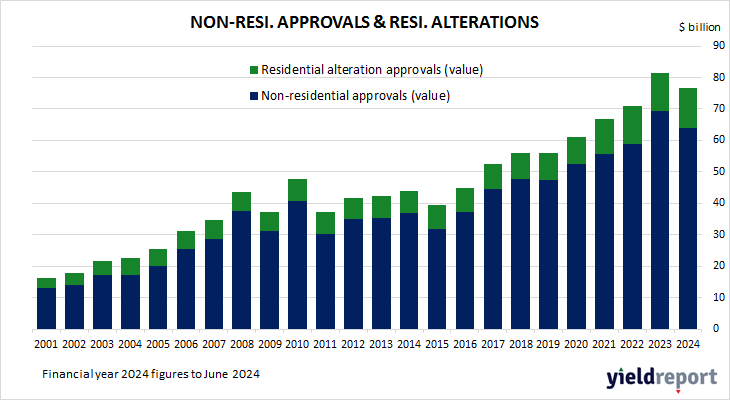Summary: Home approval numbers down 6.5% in June, fall more than expected; 3.7% lower than June 2023; Westpac miles below pace required to reach Housing Accord target; ACGB yields mostly slightly higher; rate-rise expectations over next six months firm; house approvals down 0.2%, apartments down 18.4%; non-residential approvals down 16.2% in dollar terms, residential alterations up 10.2%.
Building approvals for dwellings, that is apartments and houses, headed south after mid-2018. As an indicator of investor confidence, falling approvals had presented a worrying signal, not just for the building sector but for the overall economy. However, approval figures from late-2019 and the early months of 2020 painted a picture of a recovery taking place, even as late as April of that year. Subsequent months’ figures then trended sharply upwards before falling back through 2021, 2022 and 2023.
The Australian Bureau of Statistics has released the latest figures for June and they show total residential approvals decreased by 6.5% over the month on a seasonally-adjusted basis. The fall was a greater one the 2.8% decline which had been generally expected and in contrast with May’s 5.7% rise after revisions. Total approvals fell by 3.7% on an annual basis, up from the previous month’s revised figure of -8.2%. Monthly growth rates are often volatile.
“At 13,600 in June, total dwelling approvals are still bumping around a 12-year low and an annualised pace of just under 160,000,” said Westpac senior economist Matthew Hassan. “That is miles below the 240,000 per annum pace required to reach the Housing Accord target of 1.2 million new dwellings over the five years to 2029.”
Commonwealth Government bond yields mostly moved a touch higher on the day, with ultra-long yields the exception. By the close of business, 3-year and 10-year ACGB yields had both added 1bp to 3.95% and 4.29% respectively while the 20-year yield finished 1bp lower at 4.63%.
Expectations regarding rate rises in the next six months firmed slightly. Cash futures prices at the end of the day implied the cash rate has some chance of rising above the current rate of 4.34% in the short-term, with an average of 4.39% in August and 4.415% in November. However, February 2025 contracts implied 4.335% and May 2025 contracts implied 4.165%, 18bps less than the current cash rate.
Approvals for new houses slipped by 0.2% over the month, in contrast with May’s 1.2% rise after revisions. On a 12-month basis, house approvals were 10.9% higher than they were in June 2023, down from the previous month’s comparable figure of 12.1%.
Apartment approval figures are usually a lot more volatile and June approvals for this category dropped by 18.4% after a 15.3% rise in May. However, the 12-month contraction rate slowed from May’s revised rate of 32.4% to 26.0%.
Non-residential approvals dropped by 16.2% in dollar terms over the month and were 50.6% lower on an annual basis. Figures in this segment also tend to be rather volatile.
Residential alteration approvals rose by 10.2% in dollar terms over the month and were still 16.8% higher than in June 2023.



